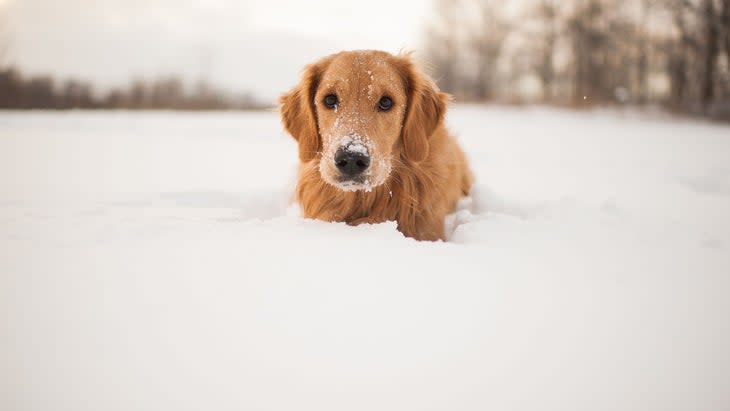How to Winterize Your Hiking Dog
This article originally appeared on Backpacker
Seek Proper Terrain
Use groomed or well-traveled trails. Cross-country ski or snowshoe trails are ideal for dogs--call ahead to see if they're allowed--because packed tracks prevent your pooch from postholing. If you'd rather hike untracked areas, reduce your expected mileage by as much as half (to account for fatigue). Breaking trail is hard for a dog; train him to follow you.
Avoid hiking near frozen streams and lakes. If your dog wanders onto ice less than two inches thick, he could fall through into frigid water. Attempting a rescue puts you at risk, too.
Stay in class II terrain. "Dogs aren't technical climbers," says Berger. Avoid terrain with precipitous drops or inclines, which are more treacherous when covered with ice.
Leash him. If your dog doesn't heel within arms reach, keep him leashed, especially in high-traffic snowmobile and skier areas, and in avy terrain where his roaming could trigger a slide.
Gear Up for Protection
Prevent heavy ice buildup on your pet's chest and legs with a coat like the full-coverage Ruff Wear Cloud Chaser ($90). Fit the jacket by measuring back length and the widest part of the chest (see below).
The Dog Buff ($12), an eight-inch long neck gaiter made of polyester microfiber with a reflective stripe, helps prevent chilling and snow buildup on floppy ears and shaggy necks.
With a properly fit pack, a dog can carry up to one-third of its body weight. Reduce his load if the snow is soft or he's postholing excessively. Fit the pack: Adjust the harness so it's snug across the forelegs (you should be able to fit two fingers between his chest and the straps) and slightly snugger across the belly; weight both sides equally. The pack should fit the same if he's wearing a jacket, but watch for chafing where straps overlap seams. Try Mountainsmith's K9 Dog Pack ($75).
At night, make your dog visible so you can find him more easily. The Nite Ize Spotli Rechargeable Dog Collar Light ($18) attaches to a collar so you can spot him from afar.
Prep His Paws
Trim. Fur between canines' toe pads can pack with snowballs and make walking painful. Have your vet or groomer trim the fluff even with your dog's pads before your trip. Resist the urge to trim on your own; vets have clippers that won't cut his skin.
Grease. Lube paws to prevent skin cracks caused by cold, dry air. Use a wax-based paw protectant like Musher's Secret ($16, 2.1 oz.) or a thin coating of petroleum jelly. The former may last several days, and one dose of Vaseline will protect five hours or more.
Boot up. Measure paw length and width to fit your dog for booties that protect feet against abrasive ice and snow buildup. Put them on your pup for short walks before your first hike, as he may need time to adjust. Between trips, check boots for wear, which could cause sores.
Wipe clean. Rinse paws after every winter hike. Dogs may ingest antifreeze or parking-lot salts while licking their feet clean.

Avoid Ailments
Joint pain: Exercise in low temps can exacerbate it. Berger recommends a canine-specific anti-inflammatory (like Rimadyl) for pain-prone dogs.
Hypothermia: Pooches can suffer from it, just like humans, especially if fur is wet at temps below 32degF. If he's shivering, give food and warm him in a sleeping bag. Frost-bite is rare in dogs at temps above -20degF.
Keep a Full Bowl
In calorie-depleting cold, add one or two tablespoons of veggie oil to dry food, or choose a formula with high fat content like Eagle Pack's Adult Power. Expect Fido to drink at least an ounce of water per pound of body weight per day, and take drinking breaks at least three times daily. Camping 72 hours or longer? Increase regular portions by 20 percent.
Originally published 2013; last updated January 2023
For exclusive access to all of our fitness, gear, adventure, and travel stories, plus discounts on trips, events, and gear, sign up for Outside+ today.